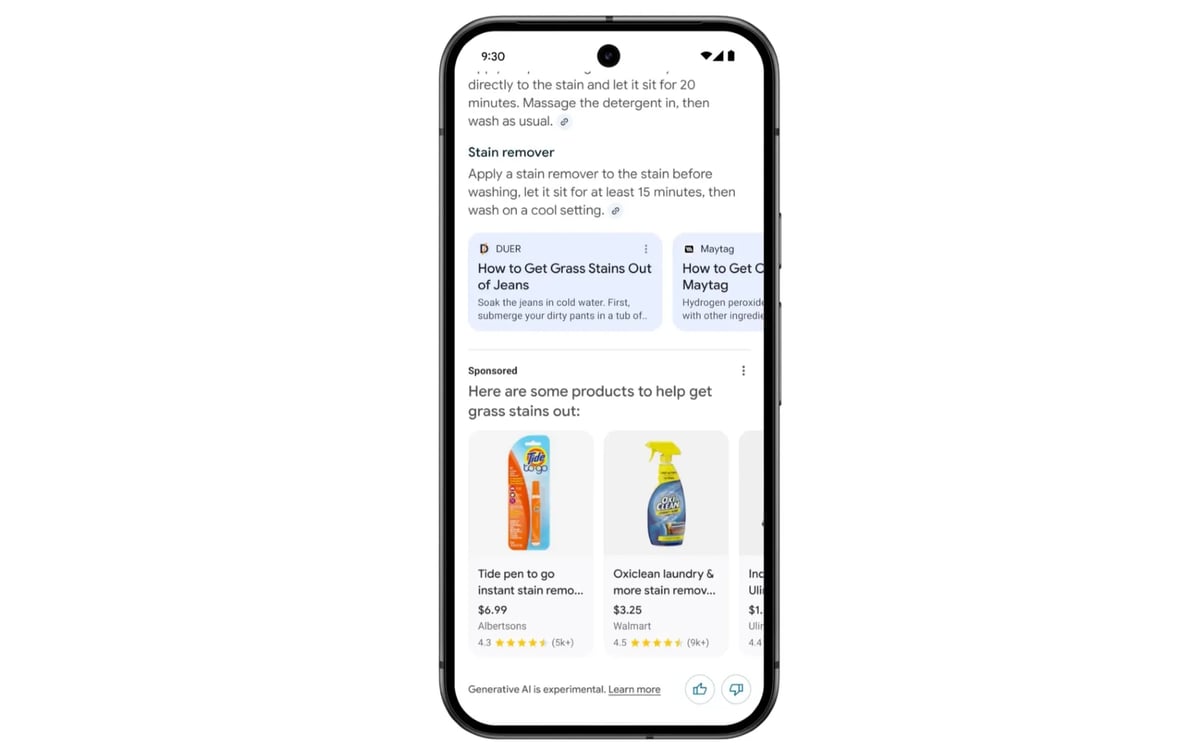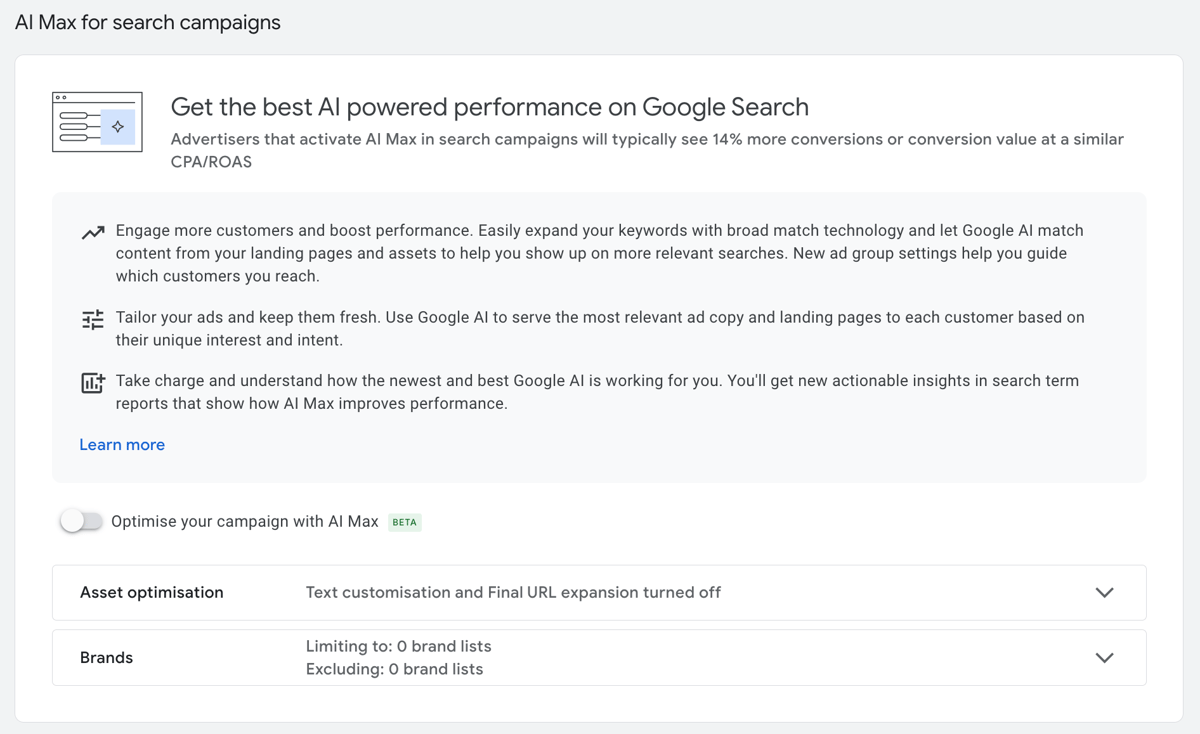Headlines declaring "search is dead" are everywhere, but here's what's actually happening: search ads aren't dying; they're evolving with AI. While AI tools handle simple queries, the $483 billion search advertising market continues growing at 8.3% annually. Google processes over 5 trillion searches per year, and their "Search & Other" revenue hit $50.7 billion in Q1 2025 alone.
Today, we're diving into the practical side: the latest AI-powered features reshaping search ads, and the 7 essential steps to optimise your campaigns for this new reality.
AI Overviews are now showing ads
Google launched AI Overviews in 2024, which are Gemini-powered snippets showing on top of search results, as a way to integrate AI with traditional searches. While ads are shown above and below AI Overview in 200+ markets, Google is now slowly rolling out ads in AI Overviews, currently available in English in the United States on mobile and desktop, and will expand to other English-speaking countries soon. Text and Shopping ads from existing Search, Shopping, and Performance Max campaigns are eligible to show within the AI Overviews. It can shorten the path from discovery to decision, and increase conversion rate.

Since ads in AI overviews are triggered only when it matches the user query and the content of the AI overviews, it is recommended to use solutions such as broad match, performance max, smart bidding, dynamic search ads, or the newly launched AI Max for search campaigns to increase the likelihood of this. For shopping ads, retailers should ensure the feeds are up to date and provide as detailed information to Google as possible. Do note that Google Ads currently doesn’t offer segmented reporting for AI Overviews ads, and they are being categorised in the “Top Ads” segment.

While Google's early beta testing shows a 14% lift in conversions at steady cost per acquisition (CPA) for AI Max, I would suggest to take it with a pinch of salt, especially for small businesses which aren’t ready for an increase in budget due to the use of more broad match keywords and smart bidding strategies. In fact, Google has shared in its recent earnings calls that AI-enhanced pages "monetise at roughly the same rate" as traditional search results. Which means showing ads in AI Overview does not show substantial differences yet.
Given these AI-powered changes to search results, how should we adapt our search campaign strategy in 2025? Here are the 7 essential steps to optimise your search campaigns for today's AI-enhanced search environment.
7 Steps to Optimise for Search Campaigns
Note that we are talking about the search campaigns, which only show text ads on Google; instead of performance max (PMax), which accesses all ads inventory from a single campaign. PMax is a smart campaign which is generally more intuitive, as for search campaigns there’s more manual work, but it’s also more controlled.
1. Decide on your search campaign structure
Think about how many campaigns you need. Is it one search campaign with a shared budget between ad groups, and the same setting? Or multiple campaigns each with its own budget and bidding strategies? This is often influenced by your business model, for example:
- Ecommerce companies that ship to multiple countries often separate the campaigns by country/ region, and allocate proportionate budget accordingly, as each region generates very different revenue.
- Corporations sometimes build an additional Brand term campaign, where the goal is to ensure that no other competitors are going to takeover when users search for their brand terms.
- Companies that have distinctive business lines will also likely build separate campaigns.
2. Create different ad groups
Once you have decided on the campaign structure, the next step is to develop the ad groups. Always build multiple ad groups by themes, audience or use cases. Let’s take a hotel for example, the different ad groups could be:
- Brand terms: keywords including hotel names
- Hotel room bookings: keywords such as “5 star hotel in California”, “best hotel in California”
- Romance packages: keywords such as “Christmas hotel package”, “Romantic getaway” based on your offerings
- Family packages: keywords such as “family hotel in California”, “hotel near Six Flags”
- F&B: “best afternoon tea for easter”, “hotel buffets”
Choosing a specific theme for each ad group ensures the ads are relevant to your keywords and serves as an AB testing for you to compare performance across ad groups. Also, some ad groups such as seasonal offers are not “always-on”, so you can switch it on only when you need it and pause the ad group when the offer is over, instead of adjusting each keyword one by one.
3. Hit the minimum basics
This is straight forward. Just memorise these best practices:
- 4 ad groups per campaign
- at least 20 keywords per ad group
- 15/15 headlines
- 4/4 descriptions
4. Make your search ad as big as possible
Essentially this means including as many ad features as possible, including sitelinks, promotions, callouts, calls, structured snippets etc, whichever that applies to your business. Here’s an example:
As you can see in the 2 ads, the one by Hyatt has occupied substantially larger ad space as it displays additional sitelinks and promotion assets on top of the description, which means it’s more likely to be detected by users. Now Google does not guarantee showing these extensions all of the time, but it’s always recommended to include as many details as possible to facilitate machine learning.
5. Understand your search quality score
Here’s the thing: Ad rank = Bid (CPC) x Quality Score
What that means is that a higher quality score can give you the same ad rank with a lower bid, essentially saving your marketing dollars. How to improve quality score? On a scale of 1-10, it is determined by 3 components:
- Expected clickthrough rate (CTR): the likelihood that your ad will be clicked when shown
- Ad Relevance: how closely your ad matches the intent behind a user’s search
- Landing Page Experience: how relevant and useful your landing page is to people who click your ad, loading speed, mobile friendliness etc
Each component is evaluated by a status of “Above Average”, “Average” or “Below Average” in your Ads account. Optimise each component to improve quality score, which ultimately improves ad rank and lowers cost.
6. Optimise your campaign every 7 days
Optimisation is a regular practice to improve campaign performance by facilitating AB testing on different elements. Very often what we think works does not achieve the expected results, and AB testing is an effective way to remove the bad apples and keep the good ones. This is important - do not change the settings more frequently than every 7 days. Google ads is a machine learning experience and it takes time for the algorithms to learn and stabilise. Changing the campaign settings too frequently will interrupt the algorithm and impact performance. What do you essentially need to do for optimisation?
- review keywords, ad copies, extensions etc
- review settings & bids
- focus on key metrics: CTR, CPC/ CPA, conversions, quality score
Another tip: only change underperforming keywords, leave the good performing ones as they are, as any change will refresh the algorithm again.
7. Discover new keywords with tools
During the course of optimisation, there will be moments where you need to insert new keywords. Your best tool is Keyword Planner within the Google Ads platform, which helps you discover new keywords, get search volume forecasts and organise keywords into ad groups. Another valuable tool is Google Trends , which is a public tool for you to explore how different search terms change over time and across countries.
Equally important: Master negative keywords While adding relevant keywords expands your reach, negative keywords protect your budget from irrelevant traffic. This becomes especially critical when using broad match keywords or AI Max for search campaigns, as these strategies cast wider nets that can trigger your ads for unintended searches. Regularly review your search terms report and add negative keywords to prevent irrelevant queries from triggering your ads, thus improving ROI and ensuring your budget focuses on qualified prospects.
The LLM revolution hasn't made search ads obsolete; it's made them more sophisticated. By implementing these 7 steps while embracing AI-powered features like broad match and AI Max, you'll position your campaigns to thrive in the evolving search landscape with just 30 minutes of weekly optimisation.
The search landscape is evolving rapidly, so stay updated on the latest changes and trends to maintain your competitive edge.







